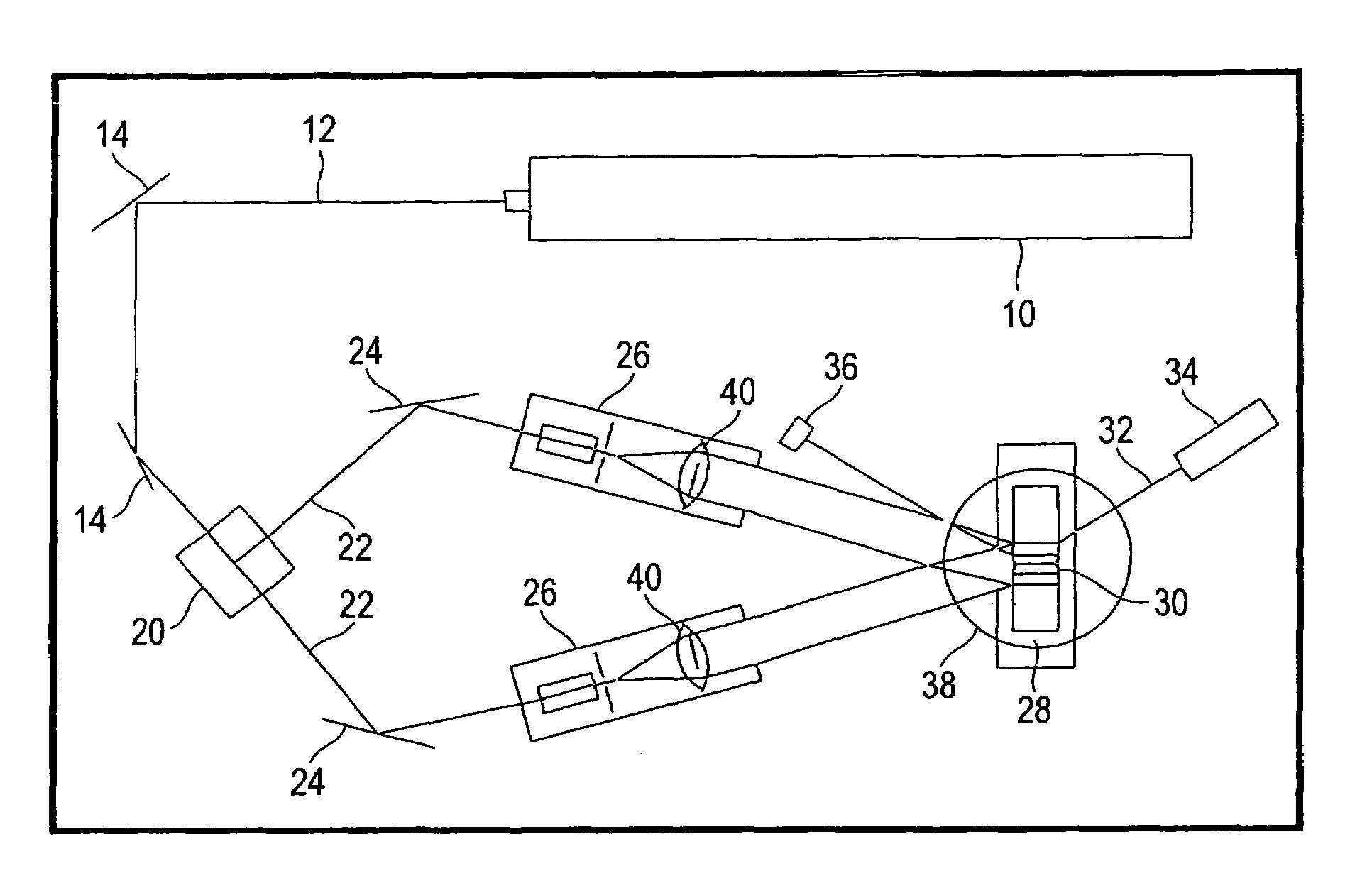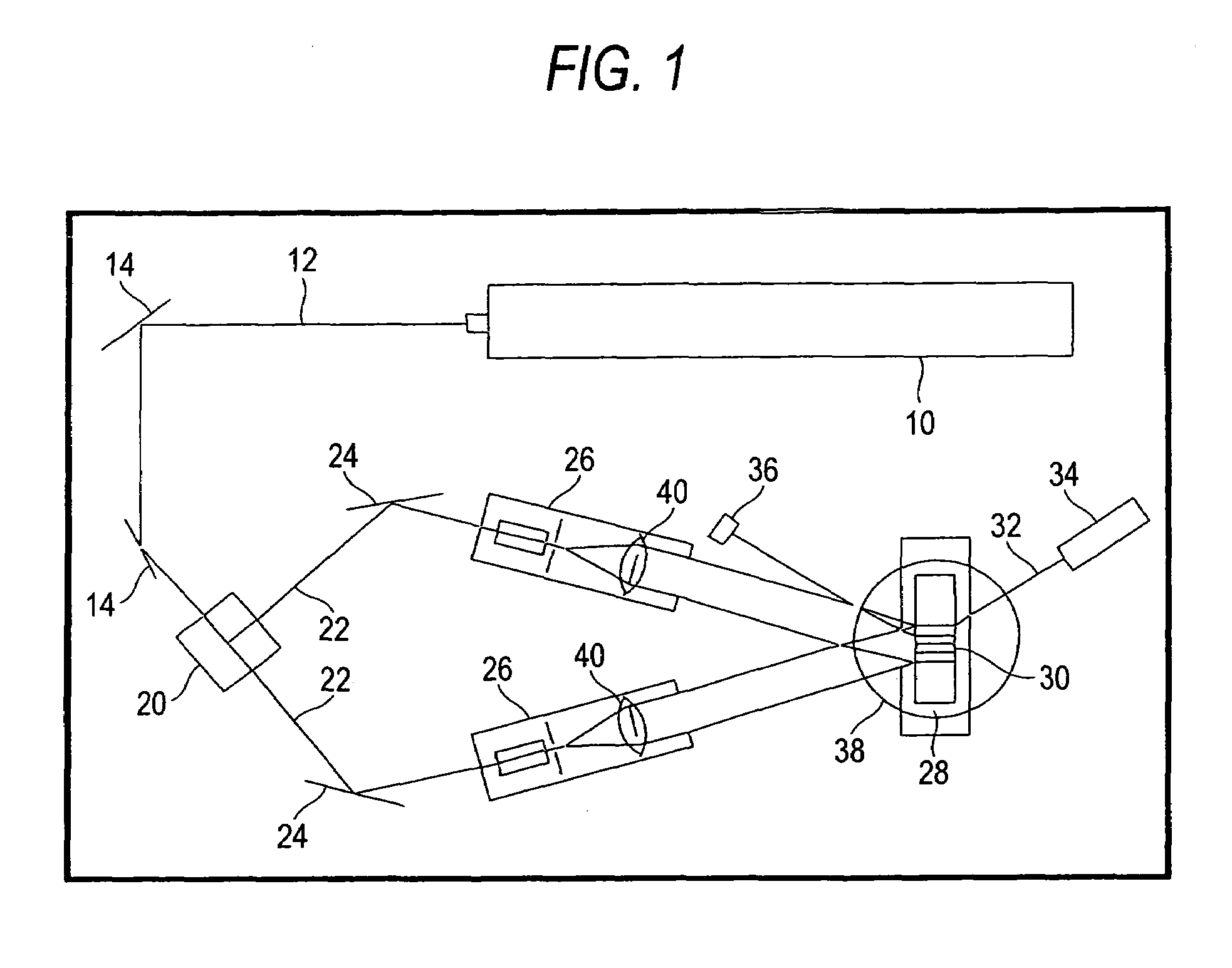Hologram recording material, hologram recording method and optical recording medium
a recording material and optical recording technology, applied in the direction of photosensitive materials, instruments, auxillary/base layers of photosensitive materials, etc., can solve the problems of inability to anticipate the future demand for sufficient recording capacity, difficult to meet these requirements at the same time, and not known a material that can satisfy all the requirements, etc., to achieve satisfactory storage, high sensitivity, and high diffraction efficiency
- Summary
- Abstract
- Description
- Claims
- Application Information
AI Technical Summary
Benefits of technology
Problems solved by technology
Method used
Image
Examples
example 1
Hologram Recording Method by Polymerization Method
[0414]A sensitizing dye DEAW (compound S-31), described in JP-A-6-43634, example 1, has a molar absorption coefficient of 17,600 at 532 nm in a film of a composition of the example 1, and is therefore not included in the present invention for a hologram recording wavelength of 532 nm. However, the S-31 can become a sensitizing dye meeting the requirements of the invention at a suitable hologram recording wavelength other than 532 nm.
[0415]On the other hand, cyanine sensitizing dyes S-92 and S-93 in the composition film of the example 1 respectively have molar absorption coefficients of 2,800 and 1,400 and therefore constitute sensitizing dyes meeting the requirements of the invention for a hologram recording wavelength of 532 nm.
[0416]As described in JP-A-6-43634, example 1, there were employed a radical polymerization initiator I-2 by 1.20 mass %, a chain transfer agent MBO by 1.80 mass %, a monomer POEA by 46.5 mass %, cellulose ac...
example 2
Hologram Recording Method by Color Developing Method
[0426]In a color developing method of the invention shown in the following, a sensitizing dye DEAW (compound S-31), described in JP-A-6-43634, example 1, has a molar absorption coefficient of 18,300 at 532 nm in a film of a composition of the example 1, and is therefore not included in the present invention for a hologram recording wavelength of 532 nm. However, the S-31 can become a sensitizing dye meeting the requirements of the invention at a suitable hologram recording wavelength other than 532 nm.
[0427]Also a sensitizing dye S-67, described in JP-A-11-512847, example 1, has a molar absorption coefficient of 13,000 at 532 nm in a film of a composition of the example 1, and is therefore not included in the present invention for a hologram recording wavelength of 532 nm. However, the S-67 can also become a sensitizing dye meeting the requirements of the invention at a suitable hologram recording wavelength other than 532 nm.
[0428...
example 3
Hologram Recording Method by Color Erasing Method (Sensitizing Dye+Color-Erasable Dye)
[0449]In a color erasing method of the invention shown in the following, a sensitizing dye DEAW (compound S-31), described in JP-A-6-43634, example 1, has a molar absorption coefficient of 18,000 at 532 nm in a film of a composition of the example 1, and is therefore not included in the present invention for a hologram recording wavelength of 532 nm. However, the S-31 can become a sensitizing dye meeting the requirements of the invention at a suitable hologram recording wavelength other than 532 nm.
[0450]Also a sensitizing dye S-67, described in JP-A-11-512847, example 1, has a molar absorption coefficient of 14,000 at 532 nm in a film of a composition of the example 1, and is therefore not included in the present invention for a hologram recording wavelength of 532 nm. However, the S-67 can also become a sensitizing dye meeting the requirements of the invention at a suitable hologram recording wav...
PUM
| Property | Measurement | Unit |
|---|---|---|
| thickness | aaaaa | aaaaa |
| recording wavelength | aaaaa | aaaaa |
| wavelength | aaaaa | aaaaa |
Abstract
Description
Claims
Application Information
 Login to View More
Login to View More - R&D
- Intellectual Property
- Life Sciences
- Materials
- Tech Scout
- Unparalleled Data Quality
- Higher Quality Content
- 60% Fewer Hallucinations
Browse by: Latest US Patents, China's latest patents, Technical Efficacy Thesaurus, Application Domain, Technology Topic, Popular Technical Reports.
© 2025 PatSnap. All rights reserved.Legal|Privacy policy|Modern Slavery Act Transparency Statement|Sitemap|About US| Contact US: help@patsnap.com



